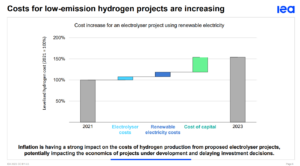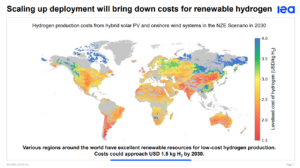
As the world struggles with transition to sustainable energy sources, green hydrogen has emerged as a promising alternative to fossil fuels. This shift is driven by the potential of green hydrogen to significantly reduce carbon emissions and provide a reliable energy storage solution for renewable energy systems. However, the cost of green hydrogen production remains a critical barrier to its widespread adoption. Recent studies have shed light on innovative strategies and technological advancements that could make green hydrogen a viable and cost-effective energy source.
Renewable energy sources like wind and solar are pivotal for a sustainable future, yet their intermittent nature poses significant challenges. Efficiently storing excess energy produced during peak periods is crucial to ensure a steady supply of electricity even when wind or solar conditions are unfavourable. Hydrogen storage, which involves compressing hydrogen into tanks, cooling it to a liquid, or binding it with materials, presents a promising solution.
READ I Forest fires in Uttarakhand: Count on women to save environment
Challenges of energy transition
Each method of hydrogen storage has its own set of advantages and challenges. For instance, while compressing hydrogen into tanks is relatively straightforward, it requires substantial energy to achieve the necessary pressure levels. On the other hand, binding hydrogen with metals or storing it in chemical compounds can enhance safety and reduce volume, but these methods often involve complex and costly processes. Adsorbing hydrogen onto materials like activated carbon presents a promising balance, offering safer storage with less energy consumption. Understanding these processes is crucial for optimising hydrogen storage technologies and making them economically viable on a large scale.

A study by Turkish researchers showed that integrating hydrogen storage at renewable energy plants could significantly reduce energy costs. Their models suggested that large-scale adoption of hydrogen storage in Germany could cut the nation’s energy costs by nearly 60% compared with current systems. Similarly, the Netherlands could see a 58% fall in energy costs by utilising hydrogen storage.
Focus on green hydrogen storage
The environmental benefits of green hydrogen are equally compelling. The life-cycle emissions of green hydrogen are significantly lower than those of traditional fossil fuels. For example, producing one kilogram of green hydrogen results in approximately 1 kilogram of carbon dioxide emissions, compared with over 10 kilograms of CO2 for the same amount of petroleum. This substantial reduction in emissions underscores the potential of green hydrogen to mitigate climate change impacts, making it a vital component of any comprehensive strategy for reducing greenhouse gas emissions.
Denizhan Guven of Istanbul Technical University emphasise the game-changing potential of green hydrogen, stating that optimal scales of hydrogen storage could transform energy systems. However, he notes that the challenges associated with hydrogen’s flammability and the high-pressure conditions required for its storage.

The flammability of hydrogen and the high-pressure conditions required for its storage pose significant safety challenges. These factors make current hydrogen storage systems expensive and complex. Despite these hurdles, ongoing research and technological advancements are expected to drive down costs. For instance, innovations in material science are leading to the development of safer and more efficient hydrogen storage solutions, which will be crucial for the widespread adoption of green hydrogen.
Combining batteries and hydrogen
A report from Stanford University, published in iScience, explored the potential of combining battery storage with hydrogen fuel cells to achieve a 100% clean electricity grid. The study, which examined 145 countries, found that transitioning to renewable energy sources like solar, wind, hydroelectric, and geothermal, combined with efficient energy storage, could reduce annual energy costs by around 61%.
Mark Z. Jacobson, the author of the study, noted that the first step is to electrify all energy sectors, significantly reducing energy demand by 38% on average. The next step involves providing electricity exclusively through wind-water-solar sources and storage, eliminating the need for fossil fuels. This approach not only lowers costs but also ensures the reliability of the energy grid.

While existing hydropower and batteries can ensure grid reliability, adding green hydrogen storage can further reduce energy costs in some regions. However, the upfront costs of hydrogen storage remain a challenge. Policymakers can help address this by prioritising funding for battery storage and green hydrogen over other less effective solutions.
Offshore green hydrogen production
H2SEA, in collaboration with Delft University of Technology, investigated cost reduction strategies for offshore green hydrogen production. By integrating different transformers and optimising energy storage systems, they claimed a 75% decrease in energy storage system costs. One of their key findings was that decentralised hydrogen production on monopile-based support structures of offshore wind turbines is structurally feasible and can significantly reduce infrastructure requirements.
H2SEA’s research indicates that integrating different transformers and using smart ESS technologies can drastically reduce space and cost per megavolt-amperes. These innovations not only cut down on infrastructure costs but also enhance the efficiency of hydrogen production and storage processes. By minimising the physical footprint and maximising energy output, these advancements contribute to making green hydrogen a more attractive and feasible energy option.
This innovative approach to hydrogen production leverages offshore wind power, providing a stable and abundant energy source for green hydrogen production. Such advancements could play a crucial role in reducing the overall costs of green hydrogen and making it more competitive with fossil fuels.
Regulatory framework and cost cut
The European Commission’s recent regulations on green hydrogen have sparked controversy. Industry players argue that the regulations are too strict and could increase production costs, while non-governmental organisations (NGOs) criticise them as being too lenient, potentially leading to higher greenhouse gas emissions.
Despite the debates, the European Commission’s framework is designed to support the rapid scale-up of green hydrogen production. The delegated acts seek to balance strict environmental standards with the practicalities of industrial implementation. For instance, by allowing certain flexibilities in power purchase agreements, the regulations aim to ensure that green hydrogen remains competitive while still adhering to renewable energy targets. This regulatory clarity is essential for attracting investments and fostering innovation in the green hydrogen sector, ensuring that Europe remains at the forefront of the global energy transition.
A study comparing different power purchase scenarios found that allowing unrestricted electricity mix usage for hydrogen production does not necessarily increase emissions and could notably decrease production costs. The European Commission’s transitional regulations, which support a green hydrogen production ramp-up, can result in similar cost reductions while ensuring high renewable electricity usage.
Efforts to reduce the cost of green hydrogen are critical for its viability as an alternative to fossil fuels. Advances in hydrogen storage technologies, combined approaches using batteries and hydrogen fuel cells, innovative offshore production strategies, and supportive regulatory frameworks all contribute to making green hydrogen more cost-effective and reliable.
As research and development progress, and as economies of scale are achieved, the cost of green hydrogen is expected to decline, paving the way for a sustainable energy future. Policymakers and industry stakeholders must collaborate to overcome the current challenges and unlock the full potential of green hydrogen as a clean and efficient energy source.
